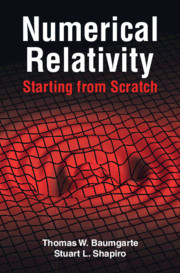
-
Select format
-
- Publisher:
- Cambridge University Press
- Publication date:
- 12 February 2021
- 08 April 2021
- ISBN:
- 9781108933445
- 9781108844116
- 9781108928250
- Dimensions:
- (229 x 152 mm)
- Weight & Pages:
- 0.52kg, 234 Pages
- Dimensions:
- (229 x 152 mm)
- Weight & Pages:
- 0.39kg, 234 Pages
You may already have access via personal or institutional login
Book description
Numerical relativity has emerged as the key tool to model gravitational waves - recently detected for the first time - that are emitted when black holes or neutron stars collide. This book provides a pedagogical, accessible, and concise introduction to the subject. Relying heavily on analogies with Newtonian gravity, scalar fields and electromagnetic fields, it introduces key concepts of numerical relativity in a context familiar to readers without prior expertise in general relativity. Readers can explore these concepts by working through numerous exercises, and can see them 'in action' by experimenting with the accompanying Python sample codes, and so develop familiarity with many techniques commonly employed by publicly available numerical relativity codes. This is an attractive, student-friendly resource for short courses on numerical relativity, as well as providing supplementary reading for courses on general relativity and computational physics.
Reviews
'Computational general relativity has now become a central tool for the exploration of the astrophysical universe, and gravitational-wave astronomy would not be possible without it. A burgeoning or seasoned astrophysicist who wishes to be up to date must therefore acquire an awareness of the field's methods and main achievements. But where to begin? With this book! Baumgarte and Shapiro are leading experts (indeed, founding experts) of this field, and with their trademark lucid and engaging prose, they take us gently by the hand on a comprehensive guided tour. Mysterious notions (lapse, shift, extrinsic curvature, constraint equations) are introduced seamlessly, and the book features a gallery of the field's most important results to date. A superb achievement for the great benefit of the scientific community.'
Eric Poisson - University of Guelph; author of A Relativist’s Toolkit
'Numerical relativity well deserves its reputation as a subject of great beauty yet prodigious conceptual difficulty and daunting technical complexity. This outstanding text, by two leading practitioners of the field, is a wonderful Rosetta Stone for those seeking an efficient path toward a working knowledge of the subject. For me it will serve as an essential reference. I’m sorry only that it was not available sooner.'
Robert Eisenstein - Massachusetts Institute of Technology
'This is an excellent book explaining the general relativistic two-body problem and its numerical treatment in a highly pedagogical manner to a broad scientific audience. Besides the main topic, readers will also gain some unexpected insight and new viewpoints on numerous wider aspects of Einstein’s theory.'
Ulrich Sperhake - University of Cambridge
'Black holes and gravitational waves are, thanks to new observations, fast-advancing frontiers of astronomy that attract wide interest. Their implications are best addressed by powerful computers, so this text, by two acknowledged world experts, is especially welcome and timely.'
Martin Rees - Astronomer Royal; author of Gravity’s Fatal Attraction
Contents
Metrics
Altmetric attention score
Full text views
Full text views help Loading metrics...
Loading metrics...
* Views captured on Cambridge Core between #date#. This data will be updated every 24 hours.
Usage data cannot currently be displayed.
Accessibility standard: Unknown
Why this information is here
This section outlines the accessibility features of this content - including support for screen readers, full keyboard navigation and high-contrast display options. This may not be relevant for you.
Accessibility Information
Accessibility compliance for the PDF of this book is currently unknown and may be updated in the future.


